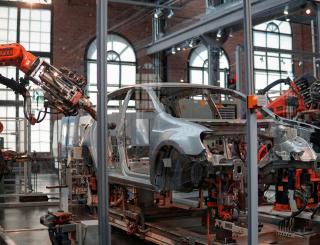For GM, it’s “people, environment, communities” first: “As we transition to an all-electric future, our solutions have to account for inequities”

In this second of a two-part series, Monica Walker, Renewables and Energy Strategy Manager at General Motors (GM), lays out the automaker’s commitment to tackling inequities, enabling EV access in vulnerable communities, and the initiatives that are making it happen. Click here to read the first part of the series.
Part II
Community stewardship
As GM works to meet its 100 percent renewable energy goal in the U.S., it will continue to focus on market solutions to help reduce emissions near the communities in which it operates. Monica Walker, Renewables and Energy Strategy Manager at General Motors (GM), notes that the way GM sources energy to power its facilities and products is essential to the company’s zero-emissions, all-electric vision.
“From a renewables perspective, we do our best to source renewable energy in the same grid that our facilities are located in to really try and get that localized emissions reduction,” she said. “A big part of that has been signing virtual power purchase agreements in the same grid that our facilities are located in. But we try to go even further with that and support localized utility offerings.”
GM has signed onto green tariff programs in Michigan with DTE and Consumers Energy – two of its largest utility suppliers for the company’s facility footprint. The automaker has also partnered on a tariff program with the Tennessee Valley Authority for the company’s Spring Hill Assembly facility in Tennessee and Bowling Green Assembly facility in Kentucky. In addition, GM looks forward to participating in the recent MPSC- approved Renewable Solutions program with Ameren Missouri to supply its Wentzville Assembly plant with clean energy.
“We’ve got these bold renewable energy goals and it’s about approaching our utilities and saying, ‘Here’s our goal, we’d really love to have localized renewable energy options. How can we work together to develop a program that allows for that?’” Walker said. “We’re really proud of our participation in those programs.”
GM recently launched several new electrification initiatives, like GM Energy, which will utilize its Ultium platform to provide greater resiliency, energy independence and grid decarbonization solutions to commercial, retail and EV customers, including applications such as stationary storage, vehicle-to-home and vehicle-to-grid technology.
These types of integrated offerings will help enable compatible EVs to be leveraged as a mobile source of energy, allowing customers to provide power to their homes or businesses when it is unavailable from the grid, or even store energy that can be sold back to the utility during periods of peak demand.
“We see working with utilities as really critical for driving overall grid decarbonization solutions,” Walker said.
EVerybody in
Building on its philanthropic commitment to climate action, GM doubled its commitment to its Climate Fund in 2021, dedicating $50 million to help close equity gaps in the transition to EVs and other sustainable technologies. To date, several nonprofit organizations have received grant funding to implement inclusive solutions for a zero-emissions, carbon neutral future.
“There’s a recognition that as we transition to an all-electric future, our solutions have to account for inequities,” Walker said. “We want the transition to this all-electric, carbon- neutral future to be inclusive. It’s rooted in understanding that some communities are more vulnerable to climate impacts or lack the resources to fully participate and benefit from the transition to a net-zero economy.”
GM’s Climate Fund focuses on four key areas, including the future of work, EV access, EV infrastructure equity, and climate action.
“We feel these key areas are where the business can make the most impact on, so bringing our current workforce along the journey to all electric and then also building a pipeline of diverse talent for the future as well,” Walker said. “Another one is EV access, so making sure that we’re offering different ways for folks to benefit from electrification, from ownership across a variety of EV price points, to ride sharing and transportation of goods and services.”
In addition, GM has a team dedicated to charging infrastructure, which works to roll out charging infrastructure and ensure that charging solutions are available to everyone.
“There’s a big focus on home charging, which is great for folks who own their homes. EV customers can get incentives for home installation or public charging points, depending on the vehicle brand,” Walker said. “But many folks who are not homeowners need to be able to access resources to charge publicly and easily.”
From a public charging perspective, GM is investing nearly $750 million to expand charging infrastructure across domains and will install up to 45,000 new charging stations in the U.S. and Canada over the next few years. The company also has integration relationships with 11 EV charging networks, giving GM EV drivers access to more than 110,000 charge points – and growing – throughout the U.S. and Canada.
The automaker’s Dealer Community Charging Program – Walker’s personal favorite – joins forces with GM dealers to expand charging access in communities, including underserved rural and urban areas where EV charging is often limited or non-existent. Participating dealers are eligible to receive up to 10 Level 2 charging stations. GM then connects dealers with installation providers as needed to place the charging stations at key community locations.
Since the program was announced, more than 1,100 GM dealers have enrolled, representing about a quarter of all GM dealers in North America. To date, chargers have been installed in Wisconsin, Michigan, Ohio and Illinois.
“Nearly ninety percent of the U.S. population lives within 10 miles of a GM dealership,” Walker said. “That fact blows my mind every time. And once we figured this out, we decided to leverage our dealer network to implement public charging infrastructure somewhere in their community. They know their community best, they know where people are gathering, so we’re really relying on them to make connections with their community to install those charging stations and provide that access locally.”
GM’s EV lineup
GM is rolling out a slew of electric cars in 2023, including the launch of the Chevy Silverado EV, Blazer and Equinox EVs; GMC HUMMER EV SUV, in addition to the Cruise Origin and BrightDrop Zevo 400 through its collaborative work with Cruise LLC and BrightDrop.
“We’ve got a lot of awesome vehicles coming out this year,” Walker said. “I’m really excited for the Chevy Equinox EV and the Chevy Blazer EV. It’s our goal to reach 1,000,000 units of EV capacity in North America by the end of 2025.”
The automaker has gone all in on this mission, recently joining forces with Netflix to give EVs the stage they deserve. The collaboration aims to increase the presence of EVs in Netflix-produced shows and films, while also taking steps to enable more sustainable productions.
“EVs are coming, and we need the electricity system to be fully decarbonized in order to produce these vehicles as well as charge them with clean energy,” Walker said. “So, we really value our collaboration with Trio, as they’re playing a critical role in helping us figure out how to get there.”
